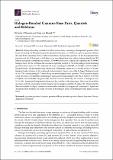Files in this item
Halogen-bonded guanine base pairs, quartets and ribbons
Item metadata
| dc.contributor.author | Thornton, Nicholas J. | |
| dc.contributor.author | van Mourik, Tanja | |
| dc.date.accessioned | 2020-09-08T15:30:02Z | |
| dc.date.available | 2020-09-08T15:30:02Z | |
| dc.date.issued | 2020-09-08 | |
| dc.identifier | 270007069 | |
| dc.identifier | eec75ed1-23a6-4967-99f5-aae92ae595f4 | |
| dc.identifier | 85090622322 | |
| dc.identifier | 000580030300001 | |
| dc.identifier.citation | Thornton , N J & van Mourik , T 2020 , ' Halogen-bonded guanine base pairs, quartets and ribbons ' , International Journal of Molecular Sciences , vol. 21 , no. 18 , 6571 . https://doi.org/10.3390/ijms21186571 | en |
| dc.identifier.issn | 1422-0067 | |
| dc.identifier.other | ORCID: /0000-0001-7683-3293/work/80257719 | |
| dc.identifier.uri | https://hdl.handle.net/10023/20585 | |
| dc.description.abstract | Halogen bonding is studied in different structures consisting of halogenated guanine DNA bases, including the Hoogsteen guanine–guanine base pair, two different types of guanine ribbons (R-I and R-II) consisting of two or three monomers, and guanine quartets. In the halogenated base pairs (except the Cl-base pair, which has a very non-planar structure with no halogen bonds) and R-I ribbons (except the At trimer), the potential N-X•••O interaction is sacrificed to optimise the N-X•••N halogen bond. In the At trimer, the astatines originally bonded to N1 in the halogen bond donating guanines have moved to the adjacent O6 atom, enabling O-At•••N, N-At•••O, and N-At•••At halogen bonds. The brominated and chlorinated R-II trimers contain two N-X•••N and two N-X•••O halogen bonds, whereas in the iodinated and astatinated trimers, one of the N-X•••N halogen bonds is lost. The corresponding R-II dimers keep the same halogen bond patterns. The G-quartets display a rich diversity of symmetries and halogen bond patterns, including N-X•••N, N-X•••O, N-X•••X, O-X•••X, and O-X•••O halogen bonds (the latter two facilitated by the transfer of halogens from N1 to O6). In general, halogenation decreases the stability of the structures. However, the stability increases with the increasing atomic number of the halogen, and the At-doped R-I trimer and the three most stable At-doped quartets are more stable than their hydrogenated counterparts. Significant deviations from linearity are found for some of the halogen bonds (with halogen bond angles around 150°). | |
| dc.format.extent | 15 | |
| dc.format.extent | 3647408 | |
| dc.language.iso | eng | |
| dc.relation.ispartof | International Journal of Molecular Sciences | en |
| dc.subject | Guanine-guanine base pair | en |
| dc.subject | Guanine ribbons | en |
| dc.subject | Guanine quartet | en |
| dc.subject | Density functional theory | en |
| dc.subject | Dispersion correction | en |
| dc.subject | QD Chemistry | en |
| dc.subject | DAS | en |
| dc.subject.lcc | QD | en |
| dc.title | Halogen-bonded guanine base pairs, quartets and ribbons | en |
| dc.type | Journal article | en |
| dc.contributor.institution | University of St Andrews. Centre for Research into Equality, Diversity & Inclusion | en |
| dc.contributor.institution | University of St Andrews. EaSTCHEM | en |
| dc.contributor.institution | University of St Andrews. School of Chemistry | en |
| dc.identifier.doi | 10.3390/ijms21186571 | |
| dc.description.status | Peer reviewed | en |
| dc.identifier.url | https://www.mdpi.com/1422-0067/21/18/6571 | en |
This item appears in the following Collection(s)
Items in the St Andrews Research Repository are protected by copyright, with all rights reserved, unless otherwise indicated.

